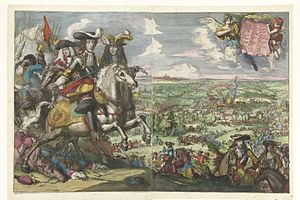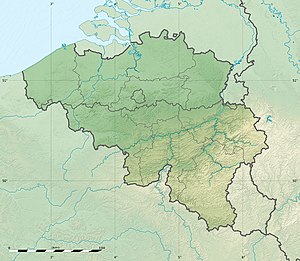
William III, also widely known as William of Orange, was the sovereign Prince of Orange from birth, Stadtholder of Holland, Zeeland, Utrecht, Guelders, and Overijssel in the Dutch Republic from the 1670s, and King of England, Ireland, and Scotland from 1689 until his death in 1702. As King of Scotland, he is known as William II. He ruled Britain and Ireland alongside his wife, Queen Mary II, and their joint reign is known as that of William and Mary.
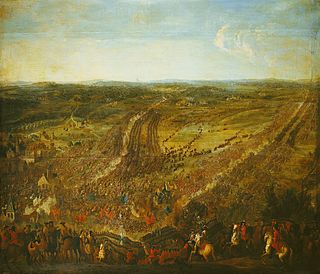
The Battle of Fleurus, fought on 1 July 1690 near Fleurus, then part of the Spanish Netherlands, now in modern Belgium, was a major engagement of the Nine Years' War. A French army led by Luxembourg defeated an Allied force under Waldeck.
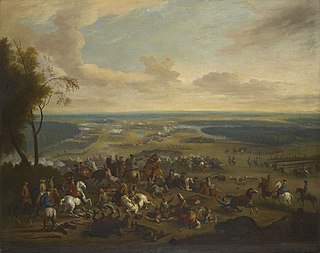
The Battle of Malplaquet took place on 11 September 1709 during the War of the Spanish Succession, near Taisnières-sur-Hon in modern France, then part of the Spanish Netherlands. A French army of around 75,000 men, commanded by the Duke of Villars, engaged a Grand Alliance force of 86,000 under the Duke of Marlborough. In one of the bloodiest battles of the 18th century, the Allies won a narrow victory, but suffered heavy casualties.

The Battle of Seneffe took place on 11 August 1674 during the Franco-Dutch War, near Seneffe, then in the Spanish Netherlands, now present-day Belgium. It was fought between a French force commanded by the Prince de Condé and a combined Dutch, Imperial, and Spanish force under William of Orange. One of the bloodiest battles of the war, over 20% of those engaged on both sides became casualties, and the result is disputed.

The Battle of Steenkerque, also known as Steenkerke, Steenkirk, Steynkirk or Steinkirk was fought on 3 August 1692, during the Nine Years' War, near Steenkerque, then part of the Spanish Netherlands but now in modern Belgium A French force under Marshal François-Henri de Montmorency, duc de Luxembourg, repulsed a surprise attack by an Allied army led by William of Orange. The Allies were forced to retreat after several hours of heavy fighting, although the French were too exhausted to follow up their victory.

The Nine Years' War, was a European great power conflict from 1688 to 1697 between France and the Grand Alliance. Although largely concentrated in Europe, fighting spread to colonial possessions in the Americas, India, and West Africa. Related conflicts include the Williamite war in Ireland, and King William's War in North America.
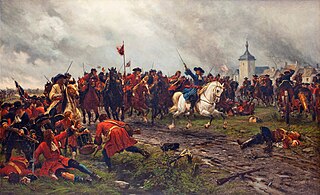
The Battle of Landen, took place on 29 July 1693, during the Nine Years' War near Landen, then in the Spanish Netherlands, now part of Belgium. A French army under Marshal Luxembourg defeated an Allied force led by William III.
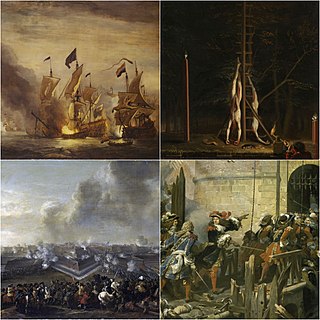
The Franco-Dutch War, also known as the Dutch War, was fought between France and the Dutch Republic, supported by its allies the Holy Roman Empire, Spain, Brandenburg-Prussia and Denmark-Norway. In its early stages, France was allied with Münster and Cologne, as well as England. The 1672 to 1674 Third Anglo-Dutch War and 1675 to 1679 Scanian War are considered related conflicts.

The Triple Alliance was signed by the Kingdom of England, the Swedish Empire and the Dutch Republic in May 1668. It was created in response to the occupation of the Spanish Netherlands and Franche-Comté by France. Although Spain and Emperor Leopold were not signatories, they were closely involved in the negotiations.

The Treaties of Peace of Nijmegen were a series of treaties signed in the Dutch city of Nijmegen between August 1678 and October 1679. The treaties ended various interconnected wars among France, the Dutch Republic, Spain, Brandenburg, Sweden, Denmark-Norway, the Prince-Bishopric of Münster, and the Holy Roman Empire. The most significant of the treaties was the first, which established peace between France and the Dutch Republic and placed the northern border of France very near its modern position.

The Battle of Cassel, also known as the Battle of Peene, took place on 11 April 1677 during the Franco-Dutch War, near Cassel, 15 km (9 mi) west of Saint-Omer. A French army commanded by the duc de Luxembourg defeated a combined Dutch–Spanish force under William of Orange.

The siege of Namur, 25 May–30 June 1692, was a major engagement of the Nine Years' War, and was part of the French grand plan to defeat the forces of the Grand Alliance and bring a swift conclusion to the war. Namur, sitting on the confluence of the Meuse and Sambre rivers, was a considerable fortress, and was a significant political and military asset. French forces, guided by Vauban, forced the town's surrender on 5 June, but the citadel, staunchly defended by Menno van Coehoorn, managed to hold on until 30 June before capitulating, bringing an end to the 36-day siege. Concerned that King William III planned to recapture the stronghold, King Louis XIV subsequently ordered his commander-in-chief, the duc de Luxembourg, to join battle with the Allies in the field, resulting in the bloody Battle of Steenkerque on 3 August.
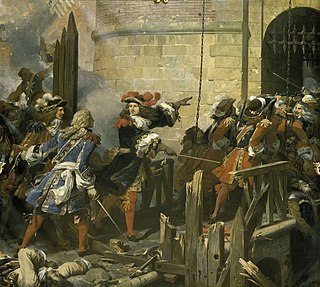
The siege of Valenciennes took place from 28 February to 17 March 1677, during the Franco-Dutch War, when Valenciennes, then in the English Netherlands, was attacked by a French army under the duc de Luxembourg.
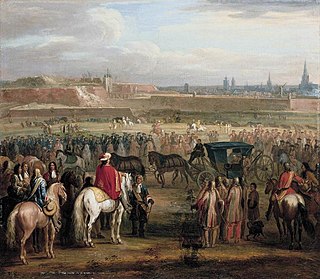
The siege of Cambrai took place from 20 March to 19 April 1677 during the 1672–1678 Franco-Dutch War; then part of the Spanish Netherlands, it was invested by a French army under the duc de Luxembourg. Siege operations were supervised by the military engineer Vauban; Louis XIV was nominally in command but played little part in operations.
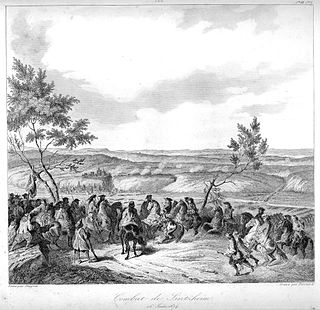
The Battle of Sinsheim took place on 16 June 1674, near Sinsheim in modern Baden-Württemberg, then in the Holy Roman Empire. Part of the 1672 to 1678 Franco-Dutch War, a French army under Marshall Turenne defeated an Imperial force led by Aeneas de Caprara.

The Battle of Entzheim, also called Enzheim, or Ensheim, took place on 4 October 1674, during the 1672 to 1678 Franco-Dutch War. It was fought near the town of Entzheim, south of Strasbourg in Alsace, between a French army under Turenne, and an Imperial force commanded by Alexander von Bournonville.

The Battle of Altenheim took place on 1 August 1675 during the 1672-1678 Franco-Dutch War near Altenheim, in modern Baden-Württemberg. It was fought by a French army of 20,000, jointly commanded by the Marquis de Vaubrun and the Comte de Lorges, and an Imperial Army of 30,000 under Raimondo Montecuccoli.
The Battle of Ortenbach, also known as the Battle of Gengenbach, took place on 23 July 1678 during the closing stages of the 1672-1678 Franco-Dutch War, in the modern German state of Baden-Württemberg. It featured a French army commanded by François de Créquy and an Imperial force under Charles V, Duke of Lorraine.

Claude Frederic t'Serclaes, Count of Tilly, was a soldier and later general in the Dutch States Army. In the Dutch army he took part in the Franco-Dutch War, Nine Years' War and the War of the Spanish Succession.

The siege of Grave took place from 25 July to 27 October in 1674 during the Franco-Dutch War of 1672 to 1678, when a Dutch army captured the Dutch fortress town of Grave in what is now North Brabant. Grave had been occupied by the French since the summer of 1672 when an army under Turenne forced the town to surrender.
